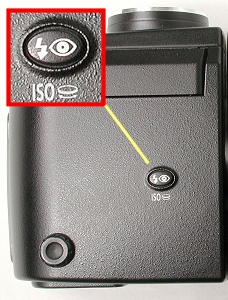What is the red-eye effect? The following is an example:

|

|
| Red-Eye effect | |
Red-eye is caused by light reflected off the subject's retina, and, as a result, a trace of red appears in the eyes of your subject. If the angle of reflection is less than 2.5 degree, red eye will occur. See the figure below. Two easy ways to overcome the red-eye effect are (1) to move closer to your subject so that the angle of reflection is larger than 2.5 degree, and (2) to shoot your subject with a different angle.

|
| The cause of red-eye effect |
Or, you can use the internal red-eye reduction capability, although it may not be very effective.
This red-eye reduction feature is only available in the program (P) mode, aperture-priority (A) mode, shutter-priority (S)mode, and manual-exposure (M) mode. To activate the red-eye reduction feature, use the FLASH button on the lens unit:

Press this button until the eye icon  appears on the LCD monitor. Once the eye icon appears, all subsequent shots
using flash will use red-eye reduction.
When red-eye reduction is in effect, do not
move the camera immediately after the shutter release button is pressed to take
a photo. The camera will fire a red-eye reduction light for about
one second, and then fire the flash to actually take the photo. Therefore,
after pressing the shutter release button, hold the camera firmly until the
internal flash fires. Note that even with this red-eye reduction feature
activated, the red-eye effect may not be gone completely. This situation could
even be worse when you take photos of your pets. See the left and middle images
below. The best way is to recompose so that the flash is not pointing directly
to your subject's eyes (the right image below). Or, consider the use of an
external flash.
appears on the LCD monitor. Once the eye icon appears, all subsequent shots
using flash will use red-eye reduction.
When red-eye reduction is in effect, do not
move the camera immediately after the shutter release button is pressed to take
a photo. The camera will fire a red-eye reduction light for about
one second, and then fire the flash to actually take the photo. Therefore,
after pressing the shutter release button, hold the camera firmly until the
internal flash fires. Note that even with this red-eye reduction feature
activated, the red-eye effect may not be gone completely. This situation could
even be worse when you take photos of your pets. See the left and middle images
below. The best way is to recompose so that the flash is not pointing directly
to your subject's eyes (the right image below). Or, consider the use of an
external flash.

|

|

|
| With red-eye reduction | Use a different angle | |
| Click on the image to see a larger one | ||
The distance between the center of the on-camera lens and the center of the internal flash is approximately 4.5cm. For convenience, let X be the distance from the camera to an eye, and a be the reflection angle (see the figure below). Then, we have X = (4.5/2) / tan(a) = 2.25/tan(a).

To eliminate red-eye, a has to be greater than 2.5 degree. Since tan(2.5 degree) = 0.04, X = 56cm. Since X is inversely proportional to a, to achieve a > 2.5 degree X < 56cm! Therefore, occasionally, red eyes still occur if the camera-subject distance is larger then 56cm.